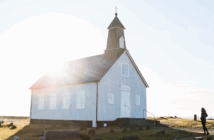Do you want amazing worship on a small church budget? Lewis Center Director F. Douglas Powe Jr. interviews Teresa Stewart, a blogger and creator of the website Paper Bag Cathedrals, on ways small congregations can enliven their worship.
Listen to this interview, watch the interview video on YouTube, or continue reading.
Doug Powe: When it comes to worship planning resources, small churches are often an afterthought. How did you come to focus on this need?
Teresa Stewart: I think most pastors of smaller congregations recognize that the resources developed out of big congregations can’t simply be dragged and dropped into smaller settings. There just is something that doesn’t work. As a student pastor at a small congregation, I started realizing that not everything I expected to work really worked. And even though I had run like heck to get out of a small hometown, I fell back in love with the people, the patterns, and the practices in my particular small place. And I began writing resources for them, testing things, and trying new things to make sure the words I was putting in their mouths were their words offered in worship.
And then a couple of terrific things happened. I was invited to teach worship and sacraments in the Course of Study, and I got a chance to watch pastors over the course of several semesters and years. During that time, I could kind of predict whose congregation was likely to flourish, not because they were necessarily the brightest students or had the best resourced church or denominational office, but because they were working a little bit differently. They were working off a different script. They were intuitively doing different things. And then, the Great Plains Conference graciously allowed me to teach three groups of laity and pastors over a year to develop and test resources. There really is a different set of tools for how worship can and should work in small places, but we’ve not necessarily been teaching them.
Doug Powe: You said you were able to predict when students would flourish in small church worship leadership. What were the signs that they intuitively knew how to conduct worship in smaller congregations?
Teresa Stewart: One was that they were not looking to replicate what excellence looks like in a large place. Instead of starting with a question like “How can we figure out how to get a great praise band?”, they started by falling in love with their own communities and looking for local gifts and local expressions. They asked, “How could people in this community get their hands on the work of the worship?” They weren’t expecting to lock down a script, knowing exactly what’s going to happen minute by minute. They were leaving some things up for grabs and intentionally including local resources and not simply what they thought were excellent resources.
Doug Powe: Can you say a little bit more about what it means to focus on who you are?
Teresa Stewart: Absolutely. I think one piece of who you are is the aesthetic out of which you worship. “Aesthetic” may sound like a big, overwhelming word. But it’s not. As human beings, we are deeply attuned to aesthetic cues all the time. Think about how COVID changed television shows. Take, for example, The Late Show with Stephen Colbert. The patterns and practices that worked when Colbert was in the Ed Sullivan Theater didn’t work when he was in his home office. He had to change his entire presentation — the timing, the jokes, the way he spoke to things — because it felt awkward or stilted outside the context of the big theater. And the same thing happened with Seth Meyers and Jimmy Fallon. They had to make big aesthetic switches.
But we don’t have to go to television to think about that. There are different aesthetic rules or principles that set our expectations regarding how we interact and respond, for example, depending on whether we’re going to a potluck birthday party at someone’s house or a formal wedding banquet. At the formal wedding banquet, you don’t expect to affect the events. You are an observer, not a participant. The order of things is set. The authorities sitting at the head table orchestrate things. But, when you go to someone’s house for a potluck, something entirely different happens. As soon as someone walks in the door with a different dish, the party changes and unfolds. It’s unscripted. You’re in the moment. If you showed up to the door and presented each potluck visitor with a bulletin and said, “Here’s exactly what’s going to happen tonight. You will be allowed to say the following words and I’m going to orchestrate,” it just wouldn’t work. We know that’s not appropriate. And yet, in many ways, we use a large “performance aesthetic” in setting the expectations for small congregations when they are the powerhouse. It’s not just who they are. When they invoke a “participation aesthetic,” they have a powerful set of tools.
I like to remind folks of the “happy birthday effect.” When you’re at a loved one’s birthday party and they carry out a cake, everyone bursts into singing “Happy Birthday to You.” Afterwards, when you’re driving home, you don’t say, “Oh, man, that was so terrible. We were out of key. The base should have practiced some more. We could have done so much more. We should have brought in a professional choir and done some more rehearsals.” You don’t say this because of the participation aesthetic. The way we burst into song together changes our critical function. We relate to it differently. And this is where smaller churches have some real advantages. Big places have to resort to excellence because they can’t get every worshipper in participation mode, in that birthday effect mode. So, we really do need to think about the immense strengths for formation in small settings with a different set of tools — not just who they are, but what they have available because of their particular setting.
Doug Powe: I’ve been to potlucks and I’ve been to small congregations where there are still people who are reluctant to participate. What do you do when people are reluctant?
Teresa Stewart: I think we can click into a mindset of saying, “Okay, we’ve got to put a checkmark beside every person for their participation.” But what I have found is that it’s the heightened sense of openness to participation that invokes the participation effect, even if everyone doesn’t actually participate. In a big setting, it’s going to go on the same whether you are there or not. The participation effect kicks in merely with the fact that someone can affect everyone else’s experience: if it’s possible for me to have an effect, that my being here mattered.
Doug Powe: What are some characteristics or tools that small congregations can use to create a worship experience that is more participatory and more local?
Teresa Stewart: I want to back up just a little bit and ground this in theology. Worship is not a dimension of a church’s life. It is the dimension. It’s where we practice ourselves. It’s where we have clarity and manifest the kingdom of God. Of all the other things that we are doing as the people of God, it is the most real. And so, I think about how all the pieces of church life intersect and run through worship.
Let’s think about the chancel area. The altar is one of the easiest places to start. In that chancel area, we are playing out the good news. It’s happening in the presence of that cross and in the presence of God as the people witness and do the work, the liturgy, themselves. So, if they are collecting canned goods to put in a community food pantry, the canned goods need to go through worship. Bring them in and stack them in front of the altar. Children’s art projects always go in, so children have the chance of offering them as a piece of themselves before God. The altar area can fill up with the signs and expressions of what we bring. The more hands-on contact, the deeper and richer that is.
I remember one Sunday I had crafted worship where people brought things forward. I had them set the altar. I put cloth in the back, and they would come in during the prelude and drape it and move it and set up. And while I was preaching, I noticed that even when I thought I had good words, their eyes were going from me to what their hands had touched, to something close by, and then back and forth. They were creating a conversation between the words and the work of their hands, whether they had placed cans or art or a personal item or had been the one who draped the altar cloths. It was in conversation with something else going on. And a year later, I can’t tell you the number of times someone would say, “Well, you remember, Teresa, when I put this up there and …” For them, the meaning was made real because it wasn’t about Teresa’s words. Preaching in conversation with the work of their hands had created something new. So, use hands-on contact to have people put all kinds of objects, local signs, and symbols up on that altar to effect the drama that we’re playing out: God with us, the kingdom of God among us. Even right here. Even these folks. Even our stuff.
Doug Powe: So, let’s back up a step. In this rich example you gave, people didn’t just show up at church one day and say, “Hey, let’s use our hands to put this cloth up on the altar.” Was there some learning or teaching that helped them understand how to do this? How can the pastor help parishioners to do exactly what you just described?
Teresa Stewart. I think it has something to do with a kind of leadership in which your job as pastor of a small congregation is not being the expert. It is asking people to engage. It’s what I call “wagering leadership.” It’s saying, “Well, I wonder how this could work? I wonder what would happen if …?” And you diagnose gifts and equip people around you to do all these things. But they may not be done exactly as you would do them. And that’s okay, too. In worship workshops, I frequently see pastors who show up alone the first time and then realize, “Oh, I have no way of talking about this stuff because it’s so different.” And then the pastor brings laity back to the next workshop. They might have a particular lay member who did all things with excellence. They set it up the right way. They did this the right way. They did that. And I try to get them to understand that the more hands you can get and the more it is the work of the people and not just the one person, the deeper the experience of the participation effect. And so, you’re looking for those who might enjoy setting it up and who have a different vision. Or you’re thinking how a child might lead the congregation or read the Scripture differently than someone else might. So, you’re diagnosing and teaching as you go, but without saying “We’re on script and it has to be done exactly this way.” It’s messy stuff.
A great way of doing worship planning for small congregations is what I call the “Stone Soup Method.” The pastor might come up with the scripture, a short description of where it’s going, and an anchor image or question but then assign people to consider: How do you want to bring people in for the call to worship? How would you invite this kind of offering? What would you do? I know one congregation where it’s become kind of a community event to stop by the pastor’s office and see the whiteboard with the names of all the different people working with the different pieces of worship that month — the pieces of that potluck and what might show up that week. In big places, there has to be a lot more structure because a crowd of 2000 gets really anxious if things feel out of control. But when was the last time you went to a fun potluck where everything felt under control? We can enjoy that sense of breathability.
Doug Powe: Can you share more about how can we authentically include children in the worship experience?
Teresa Stewart: Well, let’s start with our theology. God has this remarkable ability to show up among the least likely, least credentialed folks to reveal the kingdom of God among us. We often diminish children’s roles to “worship lite” or something cute or some kind of object lesson, which is actually developmentally inappropriate because kids’ brains aren’t wired for object lessons. We’ve got to get a lot more creative and think through what works for children. How can they lead us in worship? Congregations are often more open to changing how they relate to children. So, starting in this area can opens the door to other kinds of changes as well.
I work with 12 different models. One is a quarterly Arts Sunday. During a children’s message or at another time, children are given a clipboard, and they can pick from a whole big table of beautiful, spectacular art supplies — jars with ribbon, markers of different colors. It’s very inviting. And they are asked to answer a question: What does a saint look like to you? Or they are asked: Draw a picture of someone who’s taught you what God looks like. Now what will happen is the kids will get this at first. But eventually the congregation will want to be able to do these responses together and you can include everyone in these Arts Sundays. The key is for all of these pieces of artwork to come forward for a blessing and become part of this bigger congregation. It is remarkable how giving someone a variety of art supplies can unleash a kind of right-brained engagement when most people expect to sit and process things analytically. And when you’re in a little body, that’s just hard to do. You can give them specific instructions on what to draw or you can just say, “Draw what you think this sermon feels like and what’s interesting.” It’s not just kids who do that but adults — it unleashes that in them as well.
Doug Powe: What do you really wish for as it relates to worship and small congregations? Could you name your top wishes?
Teresa Stewart: I think the first is a deep appreciation that things need to be done differently. The history of Christian worship is about doing things for each context and each time. It isn’t simply about preserving what was flourishing and successful in one time and moving it forward. I would hope that we could rekindle this desire for the indigenous, seeing that the people in my community have gifts that belong in worship. They have abilities and words. And worship can be made rich and good and lavished with what they have and who they are, not just with outside resources, because we are “just a little church.”
Second, I hope that the larger church, the Church writ large, can be called into a different relationship with small congregations who develop resources. We need small churches to develop resources, not simply the larger churches. We’ve got an overwhelmingly muscular understanding of the aesthetics and strengths of big places, but we’re going to have to pay some attention to the aesthetics and strengths of small places, too. What’s at stake? Phyllis Tickle says every 500 years or so the church has a major rummage sale. And we’re in the middle of it. The key gift we learn from those rummage sales is — just when you think that there’s so much challenge — Christianity spreads even further, and all of those new pieces have started on the margins, edges, and in small places. And I’d love to see us recognize the value of what is occurring now in margins, in small places, and among unlikely folks in backwater areas, in places that we’re not thinking about as successful right now. What could we grow and develop in our understanding and manifestation of the kingdom of God right there with them? Because that’s about as holy a pattern in our Scriptures as I know.
Related Resources
- Be the Welcoming Church Video Tool Kit
- “Building Thriving Rural Congregations,” a Leading Ideas Talks podcast episode featuring Allen Stanton
- Revitalizing Worship is More than a Question of Style by Donna Claycomb Sokol and L. Roger Owens
- Small Church Big Impact by Blake Bradford
- Paper Bag Cathedrals, a website from Teresa Stewart with worship resources for small congregations
- Small Church, Big God, Teresa Stewart’s weekly blog of ideas and support for small congregations






